Get The Friendship Class 6 Questions And Answers With Expert Solutions
Studying for the friendship class 6 questions and answers? Chapter 2 in your English book talks about friendship and its importance. You will find class 6 english poorvi chapter 2 question answer solutions that make reading fun.
 Table of Content
Table of ContentKey points covered:
- Story questions about friends and their bond
- Word meanings from the friendship chapter
- Writing tasks about your own friends
- Grammar exercises with easy explanations
Vedantu's NCERT Solutions make every answer simple to read. Download the friendship class 6 questions and answers pdf for free and practice anytime!
These solutions help you finish homework faster. You get clear answers for all chapter questions. Check out NCERT Solutions Class 6 English for more chapters and better exam preparation.
Master The Friendship Class 6 Questions And Answers With Expert Solutions
Let Us Do these Activities Before we Read.
1. Friends are an important part of our lives. Why do you think so? Share your ideas with your friend. What do you do when you are with your friends and how do you feel?
Now, complete the following sentences by writing in the shapes given below. Share your completed sentences with your classmates and teacher. One has been done for you.
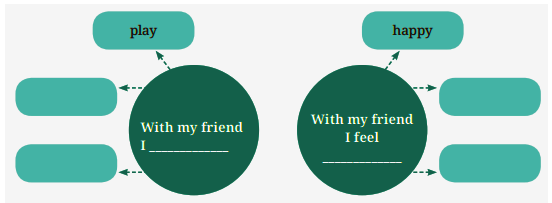
Ans:
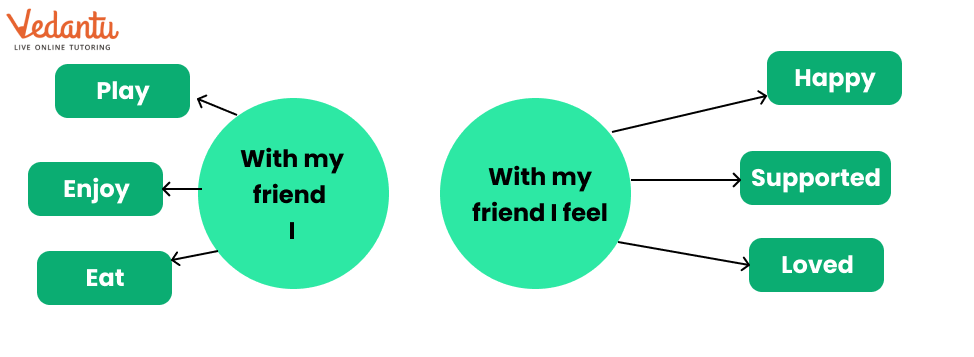
2. The title of the chapter is ‘The Unlikely Best Friends’.
(a) What can be the meaning of ‘unlikely’? Discuss in groups, and then discuss with your teacher.
Ans: The term 'unlikely' refers to something that is not expected or considered probable. In the context of friendships, 'unlikely' means that the friends are not typical or common pairs; their friendship is surprising or unusual.
(b) Can you think of some unlikely friends? Share your answer with your teacher.
Ans: Examples of unlikely friends might include a cat and a dog who get along well, or a student and a teacher who become close friends. These friendships are surprising because they go against common expectations or stereotypes.
Let us Discuss
1. Talk about the things that Gajaraj and Buntee did together. Now, write in the shapes given below. One has been done for you.
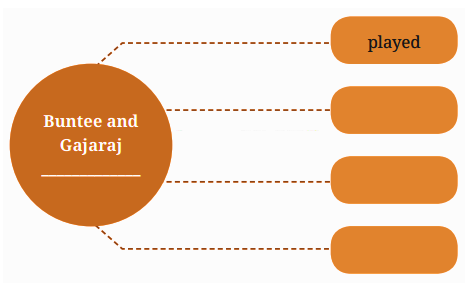
Ans:
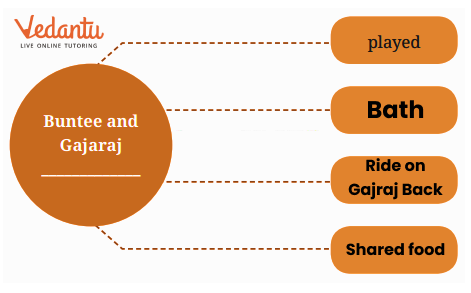
2. Why did the farmer hug Buntee?
Ans: The farmer hugged Buntee because he was overjoyed to find his lost dog. The hug expressed his relief and happiness at being reunited with Buntee.
3. Do you think Buntee will leave Gajaraj and go home with the farmer?
Ans: Yes, Buntee will leave Gajaraj and go home with the farmer. Although Buntee and Gajaraj are good friends, Buntee recognizes the farmer as his owner and understands that he must return home.
4. Why did Gajaraj not eat his food?
Ans: Gajaraj did not eat his food because he was sad and missing his friend Buntee. The separation from Buntee made him lose his appetite.
5. Who were friends at the end of the story?
Ans: At the end of the story, Gajaraj and Buntee are friends again. They were joyfully reunited, and their friendship was strengthened. Additionally, the mahout and the farmer also became friends as they shared the happy reunion of Gajaraj and Buntee.
Let us Think and Reflect
1. Read the following lines and answer the questions that follow.
(a) In spite of royal comforts, Gajaraj was sad because he had no friends. The mahout, or elephant trainer, was the only one he ever interacted with. The mahout was a kind man who served Gajaraj food, and gave him a bath in the elephant pond daily. He was a good caretaker, but not a friend.
(i) Complete with one word: mahout: kind:: Gajaraj: ___________
Ans: mahout : kind : : Gajaraj : lonely
(ii) The mahout was a good caretaker because he gave _________ to Gajaraj and a ______ in the pond.
Ans: The mahout was a good caretaker because he gave food to Gajaraj and a bath in the pond.
(iii) What do you think is the difference between a friend and a caretaker?
Ans: A friend is someone who shares emotions, provides companionship, and offers support in a personal way, making you feel understood and cared for. A caretaker, on the other hand, is someone who looks after your physical needs, such as providing food and care, but may not share a deep emotional bond like a friend does.
(b) “Are you missing your friend?” asked the farmer remembering the happy look on Buntee’s face while sitting on the elephant’s back. “I cannot see you go hungry,” said the farmer, “If you miss your friend so much, go to him.” The farmer removed the rope with which he had tied the dog.
(i) The farmer uses the word __________________ to refer to the elephant.
Ans: The farmer uses the word friend to refer to the elephant.
(ii) How did the farmer know that Buntee was hungry?
Ans: The farmer knew that Buntee was hungry because Buntee had not eaten anything since he was brought home, indicating that he was too sad and missing his friend, Gajaraj.
(iii) Why did the farmer remove the rope with which he had tied Buntee?
Ans: The farmer removed the rope with which he had tied Buntee because he realized that Buntee missed Gajaraj and was unhappy. He wanted Buntee to reunite with his friend so that both of them could be happy again.
(iv) Complete with one word: Gajaraj: Buntee:: __________: farmer
Ans: Gajaraj: Buntee:: mahout : farmer
2. Give two examples to show that Gajaraj was very happy to have a friend.
Gajaraj shared his food with Buntee when the dog first arrived, showing his joy in having company.
Gajaraj playfully splashed water on Buntee during his bath, enjoying the fun and friendship they shared together.
3. How did the mahout come to know that Gajaraj was sad?
Ans: The mahout noticed that Gajaraj had not eating his food for several days. He also observed that Gajaraj seemed uninterested and unresponsive, leading him to realize that Gajaraj was sad and likely missing his friend Buntee.
4. Why do you think Buntee licked the farmer’s hand?
Ans: Buntee licked the farmer’s hand as a gesture of affection and gratitude. It was his way of thanking the farmer for taking care of him and for understanding his need to be with his friend, Gajaraj.
5. What was ‘unlikely’ about the friendship of Gajaraj and Buntee?
Ans: The friendship between Gajaraj and Buntee was unlikely because they were very different animals—a large elephant and a small dog. Despite their differences in size and species, they formed a deep bond and became best friends, which is what made their friendship so unique and unexpected.
Let us Learn
1. Gajaraj was sad without a friend and when he met Buntee, he was filled with joy. ‘Sad’ and ‘filled with joy’ are opposites. Opposites can also be formed by adding some letters before a word. For example, un- unhappy, in- incorrect, dis- disconnect, mis-misuse.
Now, take help from the words given as hints and fill up their opposites in the puzzle. (Note: All the words are from the story you have just read.)
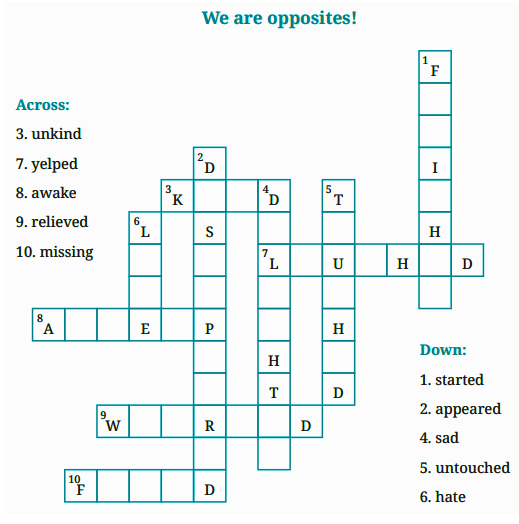
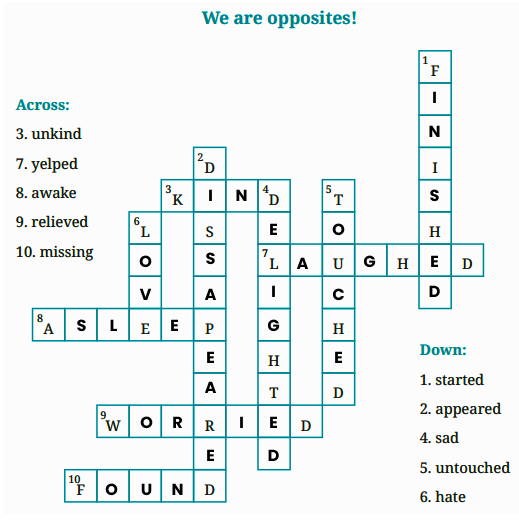
2. Now, complete the paragraph with some of the words you have used in the puzzle.
My pencil was _____________. I was very ________________ as it was a gift from my friend. I woke up my elder brother who was ____________ on the bed. I told him that my pencil seemed to have ________________. He _______________ and told me to look under my pillow. I was ___________________ when I ______________ the pencil there.
Ans: My pencil was missing. I was very upset as it was a gift from my friend. I woke up my elder brother who was sleeping on the bed. I told him that my pencil seemed to have disappeared. He smiled and told me to look under my pillow. I was relieved when I found the pencil there.
3. The words that tell us about an action are called verbs. In the story, the author tells us what happened before. To do that, the past form of the action word (verb) is used. Let us learn about the three forms of past tense.
Here is the tabulated information based on the image:
Simple Past Tense | Past Progressive Tense | Past Perfect Tense |
Used to show that the action had happened earlier. - Second form of the verb + add -d or -ed to the verb | Used to show that the action did not finish and was going on. - I/He/She/It + was + verb + ing - We/You/They + were + verb + ing | Used to show that the action was completed. - had + third form of the verb |
Given below are some verbs from the story. Put the verbs in their correct column in the table given above.
was looking | looked | gave | had ordered |
was missing | hated | had followed | noticed |
was munching | went | had remained | served |
told | asked | felt | touched |
had tied | joined | arrived | threw |
Ans:
Past Progressive Tense | Simple Past Tense | Past Perfect Tense |
was looking | looked | had ordered |
was missing | hated | had followed |
was munching | went | had remained |
told | asked | noticed |
had tied | joined | served |
touched | ||
threw |
Select the correct form of the verb to complete the passage. Check your answers with the teacher.
The farmer came back and ____________ (noticed/was noticing/had noticed) that Buntee was sad. He ____________ (tied/ was tying/had tied) Buntee with a rope the day before. He ____________ (asked/was asking/ had asked) Buntee why he was sad. Farmer ____________ (felt/was feeling/ had felt) that Buntee ____________ (missed/was missing/had missed) Gajaraj and set him free.
Ans: The farmer came back and noticed that Buntee was sad. He had tied Buntee with a rope the day before. He asked Buntee why he was sad. The farmer felt that Buntee was missing Gajaraj and set him free.
4. ‘…neither the farmer nor the mahout noticed that the two friends were in tears.’
The words ‘neither’, ‘nor’ are used to state that the farmer and the mahout did not notice the same thing. ‘Neither, nor’ connects two negative choices. For example: Neither Rohit nor I want to play football.
When you need to choose between two things that you want, you may use ‘either, or’. For example: Rohit wants to play either cricket or kho-kho. It means Rohit wants to play cricket or Rohit wants to play kho-kho.
Discuss the given sentences with your teacher to practice.
Neither Shikha nor Anuj like to tell stories.
Either Bhavesh or Abha made this painting.
Ans:
Neither Shikha nor Anuj like to tell stories.
This sentence means that both Shikha and Anuj do not like to tell stories. It uses “neither” and “nor” to show that neither person enjoys storytelling.Either Bhavesh or Abha made this painting.
This sentence means that the painting was made by one of the two people: Bhavesh or Abha. It uses “either” and “or” to indicate that the painting was created by one of them, but not both.
Let us Listen
1. You will listen to a story about ‘Unlikely Friends’. Use exact words from the story to fill up the missing details in the paragraph. (refer to page 71 for transcript)
The leopard is a ___________ animal but it became a friend of a cow. When the leopard grew up, it left the village. It came in the _______________ to meet the cow. The leopard would sit __________________ the cow. They also played together. _____________ were surprised at their friendship.
Ans: The leopard is a wild animal but it became a friend of a cow. When the leopard grew up, it left the village. It came in the night to meet the cow. The leopard would sit beside the cow. They also played together. Villagers were surprised at their friendship.
2. Now, listen to the story again and number the sentences in the correct order. The first one has been done for you.
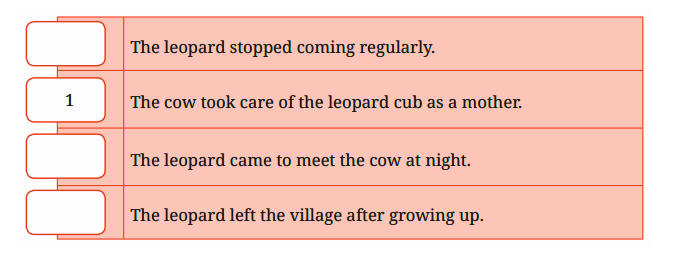
Ans:
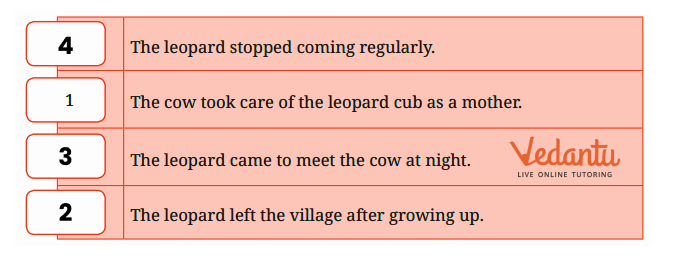
Let us Speak
Gajaraj and Buntee had a wonderful time with each other even if they were ‘unlikely’ friends. Talk to your friend and find out your common likes and dislikes. Share your answers with the class.

Ans:

Now, tell your classmates about your friend. You may take the help of the cues given below.
My friend and I like to play. Both of us want ___________.
I like to ___________ but my friend likes to ___________.
We are different as she/he is ___________ and I am ___________.
Ans:
My friend and I like to play. Both of us want to have fun together.
I like to play soccer but my friend likes to play basketball.
We are different as she/he is outgoing and I am quiet.
Let us Write
Write six sentences about your friend with the help of the facts collected in the above task. Mention how you are not only similar but also different. You may take help of the words given below.
same | different | and | but |
both | still | like | unlike |
neither | nor | either | or |
Ans:
My friend and I both like to play sports, so we enjoy spending time together.
We are the same in our enthusiasm for games, but we prefer different activities.
I like to play soccer, whereas my friend prefers to play basketball.
Unlike me, who is more quiet, my friend is outgoing.
Neither of us likes to stay indoors all the time, as we both enjoy outdoor activities.
Either we play soccer or we play basketball, but we always have fun together.
Let us Explore
1. The story, ‘The Elephant and the Dog’ is found in the Jataka tales. These stories are ancient Buddhist stories of life values and wisdom. These stories have been told from one generation to the next for over two thousand years. Find and read another Jataka story.
Ans: One of the other popular Jataka tales is "The Monkey and the Crocodile." It tells the story of a clever monkey who outsmarts a crocodile that tries to eat him. This story, like many Jataka tales, teaches important lessons about wisdom and resourcefulness.
2. Elephants have historically held significant roles in Indian culture, spanning history, warfare, religion, festivals and more. However, contemporary ecological challenges have strained the relationship between humans and elephants. Have a discussion in the class.
Ans: Elephants have been important in Indian culture for thousands of years, used in wars, religious ceremonies, and festivals. Today, they face challenges due to habitat loss and human activities. Discuss how preserving their habitats and respecting their role in nature can help improve the relationship between humans and elephants.
3. Given below is a news report from an Elephant Sanctuary in the United States about a real-life friendship between an elephant and a dog. The elephant’s name is Tarra and the dog’s name is Bella. Bella came inside a forest for elephants and became Tarra’s friend. Tarra spent most of her time with Bella. One day, Bella had an injury so she could not walk. She was kept inside a building for three weeks. Tarra stood outside for three weeks. Finally, they met and were very happy
Ans: In a real-life story from an Elephant Sanctuary in the United States, an elephant named Tarra and a dog named Bella became great friends. Bella came into the forest for elephants and quickly bonded with Tarra. When Bella got injured and couldn’t walk, she stayed in a building for three weeks. During this time, Tarra stayed outside, waiting for her friend. When Bella recovered and they finally met again, they were both very happy to be reunited.
A Friend’s Prayer
Let us do these activities before we read.
1. Read the following sentences.
(a) I wish my friend brings idli in her tiffin tomorrow.
(b) I hope my friend and I win the race tomorrow.
(c) May my friend get well soon.
Which of the three sentences (a)-(c) is closest to a prayer? Explain to your teacher and classmates.
Ans: Sentence (c) “May my friend get well soon.” is closest to a prayer. This sentence expresses a heartfelt wish for someone's well-being, which is characteristic of a prayer. Unlike the other sentences, which are more about personal desires or hopes for specific outcomes, this sentence reflects a genuine wish for the friend’s health and happiness.
2. What would you pray for your friend? First speak about it and then write it down.
Ans: Speak About It: I would pray for my friend to have good health and happiness. I hope they find joy in their daily life and succeed in their endeavours. I want them to be surrounded by caring people and to always have the strength to face any challenges.
Write It Down: I pray that my friend stays healthy and happy. May they find joy in everything they do and always be surrounded by supportive and loving people. I hope they have the strength to overcome any difficulties and achieve their dreams.
Let us Discuss
1. Read the poem silently. As you read, underline the parts of the poem that you agree with.
Ans: “May my friendships always be the most important thing to me.”
2. Now, share the details of your underlined parts of the poem in groups and explain why you liked those lines.
Ans: I underlined this line because I believe that friendships are crucial in life and should be given top priority. It resonates with me as I value my friends a lot and want to make sure they know they are important.
3. Which line was underlined by most people in your group? Share it with your teacher.
Ans: “Let me use my heart to see, to realize what friends can be.”
This line was underlined by most people in our group because it emphasizes the importance of deep emotional understanding in friendships. It resonates with us as it encourages us to truly appreciate and recognize the value of our friends.
Let us Think and Reflect
1. Complete the summary of the poem by circling the correct highlighted words.
The poet says a prayer for/speech on friendship and friends. She wants that friendship should always be an important part of her complete life/ school days. She says that her friendship makes her feel brave/special. She wishes to do the best she can, for her friends. She wants to clap for/ listen to the wishes of her friends. As a good friend, she prays/imagines that she is able to make her friend’s wishes come true. She wants her heart/mind to understand what a true friend is. She prays that she loves her friends as they are/when they are happy. She tells us that a true/correct friend accepts their friend for all their qualities.
Ans: The poet says a prayer for friendship and friends. She wants that friendship should always be an important part of her complete life. She says that her friendship makes her feel special. She wishes to do the best she can for her friends. She wants to listen to the wishes of her friends. As a good friend, she prays that she is able to make her friend’s wishes come true. She wants her heart to understand what a true friend is. She prays that she loves her friends as they are. She tells us that a true friend accepts their friend for all their qualities.
2. Answer in one word only.
(a) How does the poet feel about special friends?
Ans: Blessed
(b) What does the poet use to realise what friends can be?
Ans: Heart
3. Read the following lines from the poem and answer the questions given below.
(a) I want to do much more than share
The hopes and plans of friends who care;
I’ll try all that a friend can do
To make their wishes come true.
(i) Complete the sentence with the most suitable option.
These lines tell us that the speaker is _______________.
a. clever b. caring c. curious d. calm
Ans: b. caring
(ii) How will the speaker make her friends’ wishes come true? (by trying hard/by working a lot)
Ans: by trying hard
(iii) Fill in the blank with a suitable word.
My friends will feel __________ if their wishes come true.
Ans: happy
(b) Let me use my heart to see,
To realise what friends can be,
And make no judgements from afar,
But love my friends the way they are.
(i) The speaker says that feelings are important to understand friendship. Which line tells us this?
Ans: “Let me use my heart to see, / To realise what friends can be”
(ii) Complete the sentence with the most suitable option. These lines tell us that the speaker is _______________.
a. helpful b. thoughtful c. cheerful d. hopeful
Ans: b. Thoughtful
(iii) Fill in the blank with one word.
The speaker does not wish to make any ___________. She cares for them just as they are.
Ans: judgements
4. Give one reason why we can say that this poem is a prayer.
Ans: The poem is a prayer because the speaker expresses heartfelt wishes for the well-being and happiness of her friends, showing deep care and concern for them.
5. Why the Speaker Wants to Do More for Her Friend:
The speaker wants to do more for her friend because she values their friendship highly and wishes to actively contribute to their happiness and fulfilment by making their wishes come true.
6. Does the Speaker Know About the Wishes of Her Friend?
Yes, the speaker likely knows about her friend's wishes because she expresses a desire to make them come true, which implies she is aware of what her friend hopes for and needs.
7. Do You Pray for Your Friend? What Do You Wish For?
Personal response: Discussing this depends on individual experience. For example, "Yes, I pray for my friend to always be happy and healthy. I wish for their success and for their dreams to come true."
Let us Learn
1. The poet says, ‘With special friends I feel I’m blessed’.
Select the words that are similar to the meaning of being blessed, from those given below.
excited | grateful | understood | thankful | relaxed |
Ans: grateful, thankful
2. Good friends have a lot of qualities. Let us list some.
loyal, h e __ __ f __ l, k __ __ d, c __ __ i n g, h o __ __ __ t
Ans:
loyal
helpful
kind
caring
honest
Now, fill in the blanks with the words you just listed above.
(a) My friend is always _____________ to me even when I make a mistake.
(b) My friend shares things with me. She is very _____________.
(c) My friend is _____________ because he always supports me.
(d) My friend never lies. She is an _____________ person.
(e) My friend and I believe in _____________ for each other.
Ans:
(a) My friend is always kind to me even when I make a mistake.
(b) My friend shares things with me. She is very caring.
(c) My friend is helpful because he always supports me.
(d) My friend never lies. She is an honest person.
(e) My friend and I believe in loyalty for each other.
3. Think of any three of your friends. Write three sentences on why you like each one of them.
Ans:
Aarti is always there to listen to me when I need to talk, which makes her a very supportive friend.
Ravi is incredibly funny and always knows how to cheer me up when I’m feeling down.
Maya is someone I can trust completely; she never judges and always gives great advice.
Let us Listen
1. You will listen to a talk about some outdoor activities that two friends spend their time doing. As you listen, answer the given question in one or two word(s) only. (refer to page 72 for transcript)
(a) What do the two friends purchase and use on the park bench?
Ans: A book
2. You will once again listen to the talk about some outdoor activities of the two friends. As you listen, circle the pictures that show these activities.
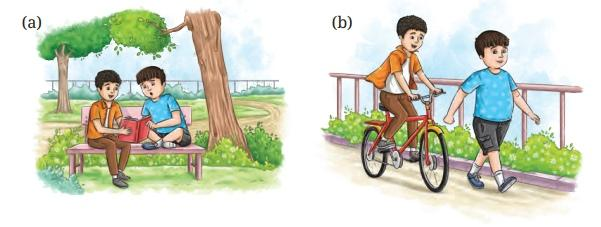
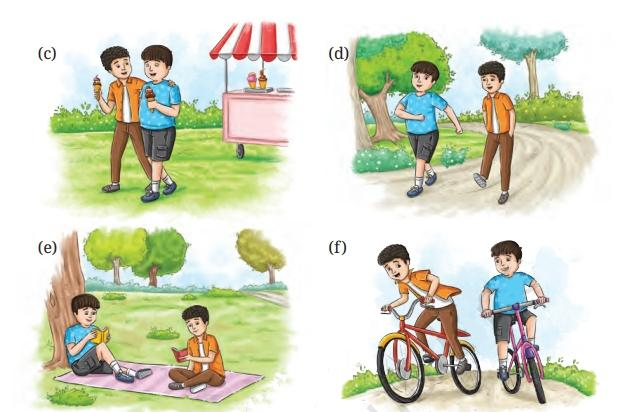
Ans:
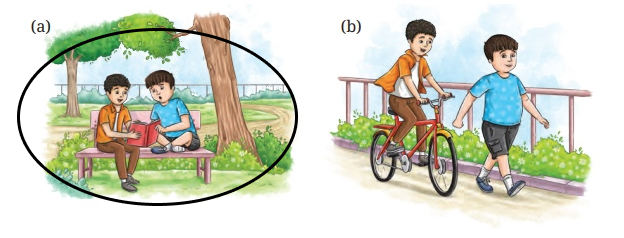
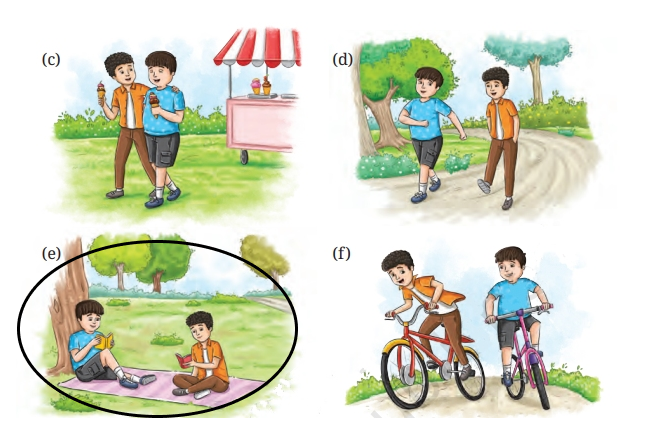
Let us Speak
1. In pairs, act the role of friends speaking to each other. Speak about the following situations:
Let us Write
Describe how your friendship with your friend started.
First list the answers for — When? Where? How?
Then, use your sentences to write a short paragraph of about 80 words.
Give a title to your paragraph.
Ans: A New Friendship in the Library
In January 2023, I met Riya at our school library. We were paired together for a class project on environmental science. As we worked on the project, we discovered we both enjoyed reading and had a passion for nature. Our collaboration made the project enjoyable and led to many shared conversations about our interests. By the end of the project, we had formed a close friendship, often meeting up to discuss books and plan weekend hikes.
Let us Explore
1. There are many quotations about friendship. Read the ones given below.
“A friend in need is a friend indeed.”
“My best friend is the one who brings out the best in me.”
(a) What do you think is the meaning of these quotations? Share it with your teacher.
Ans:
“A friend in need is a friend indeed.”
This means that a true friend is someone who supports and helps you when you're facing difficulties. They are there for you not just during happy times, but especially when you need assistance or encouragement.“My best friend is the one who brings out the best in me.”
This means that the best friends are those who help you become a better version of yourself. They inspire you to achieve your goals and support you in becoming the best you can be.
(b) Think of an experience in your life with your friend that suits this quotation. Share it with your friends.
Ans: One time, I was struggling with my school project and feeling very stressed. My best friend, Maya, spent hours helping me research and organize my work. She encouraged me and made sure I understood everything. Her support not only helped me finish the project but also made me feel more confident. This experience showed me that Maya is a true friend who brings out the best in me.
THE CHAIR
Let us do these activities before we read.
1. Write two words that come to your mind when you think of friendship.
(a) Now, find some more words that are related to friendship from the grid given below. You can search horizontally or vertically. There are eight words. One word has been marked as an example. The first letter of each word has been given in bold.
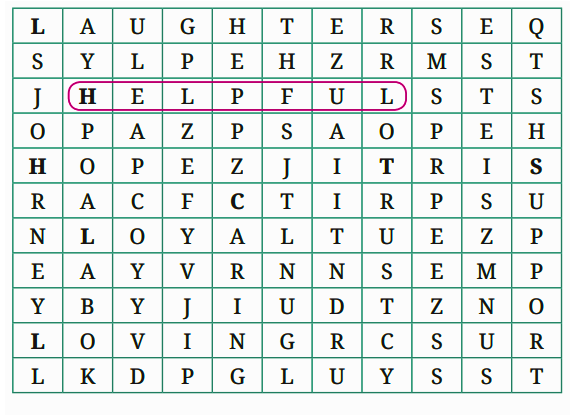
Ans:
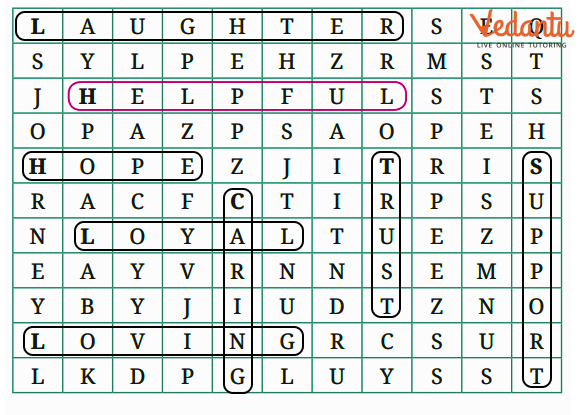
(b) Fill in the blanks to complete the words, which mean the same as ‘friend’ or ‘friends’ with the help of the meanings.
Meaning | Word |
(i) a person who you do things together with | p __ r __n __ r |
(ii) an informal word for friends | b __ __ d __ __ s |
(iii) a person who you spend a lot of time with | c __ m p __ n __ o __ |
(iv) children who are in the same class as you at school | c l __ s __ m__ t __ s |
Ans:
Meaning | Word |
(i) A person who you do things together with | partner |
(ii) An informal word for friends | buddies |
(iii) A person who you spend a lot of time with | companion |
(iv) Children who are in the same class as you at school | classmates |
(c) There are so many words for a friend. What do you call ‘a friend’ in your own language?
Ans: दोस्त (Dost)
Let us Discuss
1. Mario was very proud of having so many friends. State whether True or False.
Ans: True – Mario was very proud of having so many friends and often showed off about it.
2. What did the grandfather take from the attic?
Ans: Grandfather took an invisible chair from the attic. He told Mario that if he could manage to sit on it, he would be able to see who his real friends were.
3. Will Mario face any challenges?
Ans:Yes, Mario will face challenges. He struggles to sit on the invisible chair and falls multiple times before finally managing to sit on it.
4. Will Mario be able to use the magic?
Ans: Yes, Mario will be able to use the magic of the invisible chair. When he finally sits on it, he can see who his true friends are—those who help him instead of making fun of him.
5. Mario successfully sat on the invisible chair on his first attempt. State whether True or False.
Ans: False
6. Fill in the blank with a suitable word. Mario’s grandfather challenged him to a bet of __________.
Ans: Mario’s grandfather challenged him to a bet of "ten pounds".
7. Match the following characters with their action.
Guneet, Asma and Deepa | a. held Mario up, so he wouldn't fall b. made fun of Mario’s attempts |
Ans:
Guneet, Asma, and Deepa - a. held Mario up, so he wouldn't fall
Others - b. made fun of Mario’s attempts
Let us Think and Reflect
1. Read the following lines and answer the questions that follow.
(a) “Take it. It’s a very special chair. As it’s invisible, it’s rather tricky to sit on. But if you take it to school and manage to sit on it, then the magic will work and you’ll be able to tell who your real friends are.”
(i) Fill in the blanks with two words that describe the chair.
The chair is _____________ and ___________.
Ans: The chair is invisible and tricky.
(ii) Why was it tricky to sit on the chair?
Ans: It was tricky because the chair was invisible, making it hard to see and sit on.
(iii) Why does Mario’s grandfather call the chair ‘special’?
Ans: Mario’s grandfather calls the chair 'special' because its invisibility would help Mario discover who his real friends are.
(b) “Wait, wait, just a slight technical problem,” he said, trying again. But again, he missed the seat, causing more surprised looks and laughter. Mario wouldn’t give up.
(i) Fill in the blank with a suitable reason.
Mario says there was a technical problem because ___________.
Ans: Mario says there was a technical problem because he was missing the seat due to its invisibility.
(ii) Mario’s friends were very caring and helpful. State whether True or False.
Ans: False.
(iii) Choose the correct option to complete the sentence.
Mario wouldn’t give up. This shows he is _____________.
a. strong-willed c. loving b. supportive d. hard-working
Ans: a. Strong-willed
2. Answer the following questions.
(a) What was the bet about?
Ans: The bet was about whether Mario could sit on an invisible chair at school. If he succeeded, the magic of the chair would reveal who his real friends were.
(b) What happened when Mario sat on the chair for the first time?
Ans: When Mario sat on the chair for the first time, he missed it completely, causing surprise and laughter among his friends. He did not succeed on his first attempt.
(c) How was Mario able to find his real friends?
Ans: Mario was able to find his real friends by observing who supported him and helped him during the challenge of sitting on the invisible chair. Those who truly cared for him were the ones who helped, while others laughed or made fun.
(d) Do you think the magic chair test was good? Why do you say so?
Ans: The magic chair test was good because it helped Mario identify who his true friends were based on their support and behavior during a challenging situation. It highlighted the difference between friends who genuinely cared and those who did not.
(e) What does ‘friends for life’ mean to you?
Ans: ‘Friends for life’ means having friends who are loyal, supportive, and caring throughout all stages of life. These friends stand by you in good times and bad and maintain a lasting bond.
(f) The grandfather’s idea helped Mario find his ‘real friends’. Mention any other way that would help you find out who are your ‘real friends’.
Ans: Another way to find out who your ‘real friends’ are could be through experiencing tough situations together. Real friends will offer support and help you through difficulties, demonstrating their true loyalty and care.
Let us Learn
1. Read the following words from the text.
friendly | suddenly | talking | carrying | called | showed |
Complete the following table by dividing the words into two parts. One has been done for you.
Column A | Column B |
1. friend | ly |
2. | |
3. | |
4. | |
5. | |
6. |
Ans:
Column A | Column B |
friend | ly |
sud | denly |
talk | ing |
carry | ing |
call | ed |
show | ed |
2. Match the following root words with suitable suffixes. You can use a suffix more than once as shown. Use them to make sentences of your own. One has been done for you.
S. No. | Root Word | Suffix | Word | Sentence |
1 | magic | -ing | magical | |
2 | care | -al | ||
3 | celebrate | -ful | ||
4 | laugh | -ly | ||
5 | wonder | -ed | ||
6 | help | -tion | ||
7 | friend | -ous | ||
8 | courage | -ship |
Ans:
S. No. | Root Word | Suffix | Word | Sentence |
1 | magic | -ing | magical | The magician performed an amazing magical act. |
2 | care | -al | careful | The doctor was very careful during the surgery. |
3 | celebrate | -ful | celebrated | The team celebrated their victory joyfully. |
4 | laugh | -ly | laughingly | She responded laughingly to the joke. |
5 | wonder | -ed | wondered | He wondered about the mysteries of the universe. |
6 | help | -tion | helpful | She was very helpful to everyone in need. |
7 | friend | -ous | friendly | He has a very friendly nature. |
8 | courage | -ship | courageously | She faced the challenge courageously. |
3. Read the following lines from the story.
Mario, brave and determined, took the strange invisible chair …
You have already described the chair. Now, describe what kind of a person Mario is in the image given below.
[Use words from the story. You may also use words of your own.]
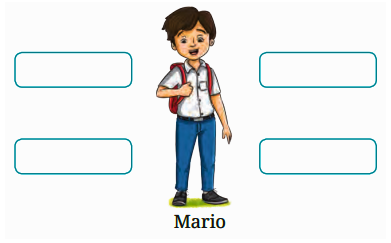
Ans:
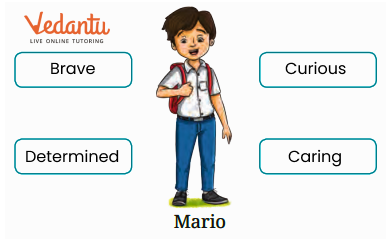
Brave: Mario showed bravery by taking on the challenge of the strange invisible chair.
Determined: He was determined to succeed, no matter how unusual or difficult the task was.
Curious: Mario’s willingness to interact with something as strange as an invisible chair suggests that he is curious and open to new experiences.
Caring: Mario might also be described as caring, as he likely approached the task with a sense of responsibility, looking out for others involved.
4. Match each word (adjectives) in Column A with a suitable word (noun) in Column B. You can make more than one combination. One has been done as an example.
Column A (Adjectives) | Column B (Nouns) | Column C (Phrases) | Column D (Sentences) |
1. brave | friends | brave soldier | |
2. clever | rain | ||
3. tasty | soldier | ||
4. heavy | plan | ||
5. slight | peanuts | ||
6. true | cold |
Ans:
Column A (Adjectives) | Column B (Nouns) | Column C (Phrases) | Column D (Sentences) |
1. brave | friends | brave soldier | The brave soldier marched ahead. |
2. clever | rain | clever rain | The clever rain made the streets slippery. |
3. tasty | soldier | tasty soldier | The tasty dish was enjoyed by the soldier. |
4. heavy | plan | heavy plan | The heavy plan required careful execution. |
5. slight | peanuts | slight peanuts | The slight peanuts added a crunch to the salad. |
6. true | cold | true cold | The true cold of winter chilled everyone to the bone. |
5. Complete the paragraph with suitable adjective-noun pairings. Use the words in the box given below.
old book | magical adventures | happy boy | amazing stories |
fantastic adventures | colourful creatures | old castles |
Once upon a time in a little village, a/an (i) __________________ named Abhishek found a/an (ii) __________________ in the attic. He read (iii) __________________ about fairy lands, (iv) __________________ and (v) __________________. Abhishek’s eyes got big as he imagined these (vi) __________________. He told his friends about the stories, and they started to have their own (vii) __________________ when they played together
Ans: Once upon a time in a little village, a/an (i) happy boy named Abhishek found a/an (ii) old book in the attic. He read (iii) amazing stories about fairy lands, (iv) old castles and (v) colourful creatures. Abhishek’s eyes got big as he imagined these (vi) magical adventures. He told his friends about the stories, and they started to have their own (vii) fantastic adventures when they played together.
Let us listen
You will listen to Manu talk about her friend, Monika. As you listen, fill in the blanks with words that you hear. (refer to page 73 for transcript)
(a) Monika found it _____________ when she took admission in the school.
(b) Manu was _____________ and helped by her in many ways.
(c) So, it was not so _____________ for the new girl to adjust in the school.
(d) Both friends experienced difficult and _____________ moments together.
(e) Manu is _____________ to Monika for making her life easy and finding a friend. You will listen to the girl once again.
Ans:
(a) Monika found it difficult when she took admission in the school.
(b) Manu was supportive and helped by her in many ways.
(c) So, it was not so hard for the new girl to adjust in the school.
(d) Both friends experienced difficult and happy moments together.
(e) Manu is grateful to Monika for making her life easy and finding a friend.
Let us Speak
1. Work in pairs. Read the following qualities of a friend.
loving | honest | kind |
caring | loyal | polite |
respectful | team-worker | understanding |
Discuss in pairs.
Choose any four positive qualities that you would like your friend to have. Give a reason for your choice. Use the hints given below when you speak.
I feel my friend should be … because …
I think the quality I want in my friend is being …. The reason for this is …
I believe my friend should be … This is in order to …
If my friend is … then …
Ans:
I feel my friend should be caring because it shows they genuinely care about my well-being and are always there to support me in times of need.
I think the quality I want in my friend is being loyal. The reason for this is loyalty ensures that our friendship is strong and unshakable, even when things get tough.
I believe my friend should be honest. This is in order to maintain trust between us. Honesty helps in resolving misunderstandings and keeps our friendship genuine.
If my friend is understanding, then they will be able to empathise with my feelings and situations, making our bond deeper and more meaningful.
Let us Write
1. Read the messages that Mario has written to his friends Deepa, Guneet and Asma.
Dear Deepa, I feel so special that you are my friend. I know you will always be there for me. Before going to bed, I said a little prayer for Guneet, Asma and you. You made me realise the value of having good friends. Best wishes, Mario |
Dear Asma, I feel blessed to know that you are my true friend. I would have fallen again today, if it wasn’t for Guneet, Deepa and you. I know I can always depend on the three of you, no matter what. Best wishes, Mario |
(a) Now, choose the correct word given in brackets to complete Mario’s message to Guneet.
Dear Guneet,
I am __________________ (thankful to/requesting) God to have you as a __________________ (lucky/real) friend for life. When everyone was __________________ (laughing at/talking to) me, Deepa, Asma and you showed me that you __________________ (will save/care for) me. You are indeed a __________________ (blessing/loving) in my life.
Best wishes,
Mario
Ans:
Dear Guneet,
I am thankful to God to have you as a real friend for life. When everyone was laughing at me, Deepa, Asma and you showed me that you care for me. You are indeed a blessing in my life.
Best wishes,
Mario
(b) Now, write your own message to your best friend. You may take ideas from the story, ‘The Unlikely Best Friends’ and the poem, ‘A Friend’s Prayer’.
Ans:
Dear Rakshitha,
I just wanted to let you know how much you mean to me. You’ve been my rock through thick and thin, and I’m so grateful to have you in my life. Like the friends in ‘The Unlikely Best Friends,’ you’ve shown me the true meaning of friendship by always being there, even when things are tough. I feel so blessed to have a friend who understands me, supports me, and makes every day a little brighter.
I hope we continue to grow together, sharing both the good times and the challenges. I’ll always keep you in my thoughts, just like in ‘A Friend’s Prayer,’ hoping that you find happiness and peace in everything you do.
Thank you for being the amazing friend that you are.
Best wishes,
Mary
Let us Explore
1. Find out more stories about ‘Friendship’. It could be from your state, other states or other countries too. You can share them with your class.
Ans:
The Story of Krishna and Sudama (India): This is a well-known story from Indian mythology about the deep bond between Lord Krishna and his childhood friend Sudama. Despite their different social statuses, Krishna welcomed Sudama with open arms when he visited, showing that true friendship transcends wealth and status.
The Fox and the Stork (Aesop’s Fables, Greece): This classic fable tells the story of how two animals learn the value of treating others with kindness and fairness, highlighting how true friends should respect and care for one another.
The Adventures of Sherlock Holmes and Dr. Watson (England): Sherlock Holmes, the brilliant detective, and Dr. John Watson, his loyal companion, share a friendship that is central to many of Arthur Conan Doyle's stories. Their partnership is a perfect example of how friends can complement each other’s strengths.
The Story of Damon and Pythias (Ancient Greece): This is a legendary tale of two friends whose loyalty to each other was so strong that they were willing to sacrifice their own lives for each other. It is a powerful reminder of the lengths to which true friends will go to support one another.
2. Describe your friends by filling in the blanks with suitable words. This is known as an acrostic poem.
F ________________
R ________________
I ________________
E ________________
N ________________
D ________________
S ________________
Ans:
Friendly
Reliable
Inspiring
Empathetic
Nurturing
Dependable
Supportive
3. Complete the following task by talking to different people of different age groups as mentioned in the table. You may divide the class into groups to do the following:
Question | Age Group | Response |
What does friendship mean to you? | 50+ | |
31 to 49 | ||
20 to 30 | ||
12 to 19 |
Ans:
Question | Age Group | Response |
What does friendship mean to you? | 50+ | "Friendship means having someone who has been with you through all the ups and downs of life. It’s about loyalty, trust, and a deep connection that withstands the test of time." |
31 to 49 | “Friendship is a support system, a network of people you can rely on for advice, comfort, and understanding, especially when life gets busy with family and work." | |
20 to 30 | Friendship is about shared experiences, laughter, and growth. It’s having people who understand you, support your dreams, and are there to celebrate or console you." | |
12 to 19 | "Friendship means having fun together, sharing secrets, and being there for each other during tough times. It’s about trust and having someone who gets you." |
After gathering responses:
Discuss: similarities and differences across age groups.
Ans:
Similarities: Across all age groups, friendship is seen as a source of support, trust, and understanding. Each group values the presence of a friend during challenging times and appreciates the deep connections that friendship offers.
Differences: The older age groups (50+ and 31 to 49) emphasise loyalty, trust, and long-term connections. They see friendship as something that has endured many life changes. The younger age groups (20 to 30 and 12 to 19) focus more on shared experiences, fun, and personal growth, reflecting the active and dynamic nature of friendships during these life stages.
Reflect: how viewpoints on friendship may change with age and life experiences.
Ans: As people age, their perspective on friendship often deepens. In youth, friendship is frequently associated with fun and companionship. As life progresses, and responsibilities like work, marriage, and parenting come into play, friendship becomes more about support and trust. Older adults may see friendship as a cherished connection that has withstood the test of time, while younger people may view it as an essential part of daily social life.
Present: a summary of the group’s responses, emphasising key themes or unique insights.
Ans:
Key Themes: Trust, support, loyalty, shared experiences, and understanding are the core elements of friendship across all age groups.
Unique Insights: Older adults value the longevity and depth of friendships, while younger people focus on the joy and growth that come from spending time with friends. The concept of friendship evolves with age, reflecting changes in life circumstances and personal priorities.
Benefits of NCERT Solutions for Class 6 English Chapter 2
NCERT Solutions for Class 6 English Chapter 2 provides detailed explanations of the chapter, helping students grasp the key concepts and themes clearly.
By reading and understanding the solutions, students can enhance their vocabulary and language skills, which are crucial for mastering English.
These solutions serve as an excellent revision tool, allowing students to quickly review important points before exams.
With accurate answers and explanations, students can gain confidence in their ability to tackle exam questions related to the chapter.
NCERT Solutions for Class 6 English Chapter 2 provides reliable support for completing homework assignments, ensuring that students can submit accurate and well-structured answers.
Important Study Material for English Chapter 2 Class 6-
S.No. | Important Study Material Links for Chapter 2 |
1. | Class 6 English Chapter 2 Important Questions |
2. | Class 6 English Chapter 2 Revision Notes |
Conclusion
NCERT Solutions for Class 6 English Chapter 2 provides students with a valuable resource for understanding the chapter's content thoroughly. These solutions not only help in enhancing language skills but also offer support in exam preparation and homework completion. By using these solutions, students can build a strong foundation in English, ensuring academic success and improved confidence in their abilities.
S.No. | Chapter Name | Chapter-wise Topics |
1 |
| |
2 |
| |
3 |
| |
4 |
| |
Related Important Links for English (Poorvi) Class 6
Along with this, students can also download additional study materials provided by Vedantu for English Class 6–
S.No. | Important Links for Class 6 English |
1. | |
2. | |
3. | |
4. |
FAQs on NCERT Solutions for Class 6 English Poorvi Chapter 2 Friendship
1. What are NCERT Solutions for Class 6 English Chapter 2 'Friendship', and how do they help students?
NCERT Solutions for Class 6 English Chapter 2 'Friendship' provide detailed, step-by-step answers to all questions from the chapter as per the latest CBSE 2025–26 guidelines. These solutions help students understand key concepts, develop comprehension, and write accurate exam responses using correct language and format.
2. How do the NCERT Solutions for Class 6 English Chapter 2 address the main message of the story ‘The Unlikely Best Friends’?
These solutions highlight the central message of valuing friendship regardless of differences. Students learn through model answers that real friendships are based on empathy, support, and kindness, as depicted by the bond between Gajaraj and Buntee in the chapter.
3. Why is ‘A Friend’s Prayer’ considered an important poem in Class 6 English Chapter 2 NCERT Solutions?
‘A Friend’s Prayer’ is important because it teaches students the qualities of true friendship, such as understanding, selflessness, and acceptance. The NCERT solutions offer explanations that help students interpret the poem’s meaning and the poet’s intentions as per CBSE criteria.
4. How can students use the NCERT Solutions for Class 6 English Chapter 2 to improve their exam answers and writing skills?
Students can refer to model answers in the NCERT Solutions for clarity on structure, content, and vocabulary. By practising these answers, they become familiar with the expected format and can write more accurate, concise, and effective responses in exams.
5. What does the story ‘The Chair’ teach according to the NCERT Solutions, and how can students apply this lesson?
‘The Chair’ teaches about identifying true friends through supportive actions. The solutions explain that students should value friends who offer real help, not just those who are present for fun, and apply this by looking for and being supportive friends in real life.
6. Are the NCERT Solutions for Class 6 English Chapter 2 aligned with the latest CBSE 2025–26 exam pattern?
Yes, all answers follow CBSE’s current marking scheme and question formats for the academic year 2025–26, ensuring students can prepare accurately for school and board assessments.
7. How do the solutions help in understanding and applying grammar topics like opposites, tenses, and adjectives introduced in Chapter 2?
The NCERT Solutions provide clear examples and exercises on grammar themes such as forming opposites (e.g., ‘sad–happy’), past tenses, and using adjectives. Stepwise answers help students grasp grammar rules and integrate them into their own writing.
8. What are some possible misconceptions about friendship that the chapter or its solutions help clarify?
The solutions clarify that friendship is not just about fun or proximity; true friends support you in challenging times. The stories show that real friends may be unexpected and that loyalty and kindness are more important than popularity.
9. In what ways can referring to NCERT Solutions for Class 6 English Chapter 2 help with quick revision before exams?
Students can use the solutions to revise key points, main themes, summary, and exam-askable questions quickly. The concise answers streamline last-minute preparation and increase confidence for both subjective and objective patterns.
10. How do the NCERT Solutions for Class 6 English Chapter 2 foster higher-order thinking or application skills?
The solutions promote analytical thinking by including application-based questions, such as comparing characters’ actions, exploring ‘what-if’ scenarios, and encouraging students to reflect on the nature of friendship beyond simple factual recall.
11. What are the benefits of using step-by-step NCERT Solutions for solving comprehension passages in Chapter 2?
Step-by-step solutions guide students through interpreting, analyzing, and answering comprehension questions, modeling explanatory reasoning that aligns with CBSE marking and improves both accuracy and scoring.
12. How do NCERT Solutions for Class 6 English Chapter 2 support vocabulary building?
The explanations include meanings, synonyms, and context usage for new words found in the chapter, helping students expand and apply vocabulary in their writing and understanding.
13. What is a key difference between a caretaker and a friend according to the solutions in this chapter?
A caretaker looks after physical needs and well-being, while a friend offers emotional support, empathy, and companionship. NCERT Solutions stress this distinction via sample answers and context from the story.
14. How can students use chapter-based solutions to practice for other similar chapters in their Class 6 English NCERT book?
By observing answering patterns, structure, and explanation depth of each solution, students can mirror the approach for other chapters, enhancing their skill in tackling both prose and poetry questions efficiently.
15. What should students remember when writing their own answers based on NCERT Solutions for Class 6 English Chapter 2?
Students should understand the concepts and reasoning behind model answers, not just memorize them. They should practice writing in their own words, maintain clarity, and align responses with CBSE requirements highlighted by the solutions.
























